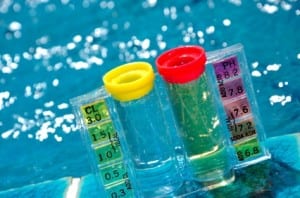If you find that once you’re in the water or have finished up swimming that you are plagued with skin sensitivity, you need to talk 
The first step for your Scottsdale, Arizona swimming pool service contractor is to ascertain whether the pool’s pH and alkalinity are in the recommended ranges. Balances on either end of the spectrum – either too low or too high — can cause skin irritation and eye redness. To keep the pool’s pH and alkalinity properly balanced you should use an accurate test kit after adding chemicals — this is something your pool contractor will do for you when he is on a service visit or something a pool owner can do between visits. The water will need to be tested at least weekly, and after a rainfall, with test strips or liquid reagents to help keep the pool in balance.
Testing the water may be a daily routine until you get the balances just right. Following the testing of the water you might find it necessary to balance out the pool’s chlorine levels as these levels can cause significant eye and skin irritation. It’s a popular pool myth that strong chlorine odor and eye irritation is caused by too much chlorine. “Free chlorine” actually has no taste or odor. When free chlorine reacts with bacteria, ammonia, or other waste products it is changed into combined chlorine or chloramines. Ammonia is released into the water from body waste and sweat. Combined chlorine – free chlorine and ammonia — has a strong odor and causes skin irritation and eye redness. There should be no combined chlorine in your pool water. Combined chlorine will prevent the chlorine from doing what it is supposed to.
Always test your water for free and total chlorine levels – this is the first step in cleansing your pool of these potential skin irritants. Testing can either be done at home, by you with a good test kit, or you can take a sample to your local pool professional. You will want to add chlorine to bring the free chlorine up to 10 times the combined chlorine; if the combined chlorine is 0.2 PPM, you will add 20 PPM free chlorine. This process is called “breakpoint chlorination” or “superchlorination,” the point where the chloramine bonds break apart.
Some individuals find that being constantly vigilant with balancing the chlorine levels is more of a chore than they want to take on and in that case, hiring a pool maintenance professional whose job is to make certain your pool is safe and clean is certainly a viable option.
There are also chemicals made of natural compounds that can be used to keep your water clean and bacteria free and will also address skin sensitivity issues that may arise. Once you determine the correct balances, though it should be as easy as daily maintenance and testing. Everyone into the pool!

